About
The publication focuses on issues and topics related to health and the environment among Indigenous communities. Featured are individuals’ journeys of experiencing environmental impacts in their home communities. Their stories include what motivated them to pursue and accomplish their goals. The magazine also highlights various youth who are taking initiatives as environmental advocates. Our youth are not waiting, but acting now in innovative ways to make changes that will improve their home communities.
|
Image

|
Image
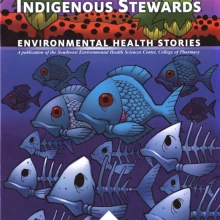
|
Image
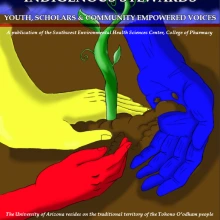
|
Image
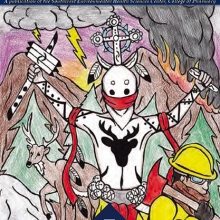
|
Image
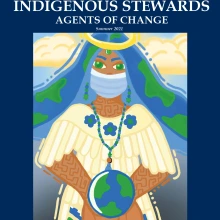
|
Navigate through the tabs below to learn more about each volume of Indigenous Stewards.
SUMMARY
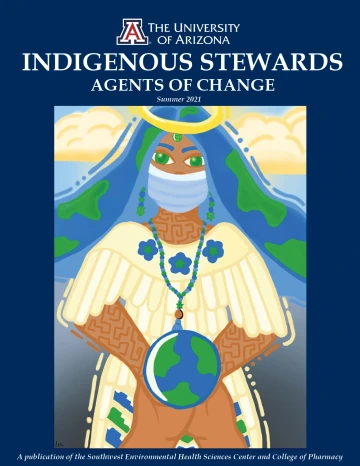
Volume five of the Indigenous Stewards magazine tells a multi-faceted story about change. The title, "Agents of Change," illustrates the resiliency of indigenous programming, students, and staff during the COVID-19 pandemic, opportunities for students addressing health equity, neuroscience research, and culturally informed community outreach and advocacy. Volume five of the magazine is unique from previous volumes in years past because although it highlights the work of indigenous staff, students, and programs, it also encompasses the strength and persistence of indigenous people through shared stories of overcoming struggles associated with the COVID-19 pandemic.
"Agents of Change" gives a top-down point of view of how indigenous professionals and students are continuing to be resilient and proactive in their efforts to be pioneers in a variety of fields over the course of the pandemic and beyond.
Stories like the ones below and so many more can be read in volume five of the Indigenous Stewards magazine: Agents of Change
University of Arizona Native American Leaders
- Continue to the full publication of volume five to learn more about how Senior Vice President for Native American Advancement, Levi Esquerra and Assistant Vice Provost for Native American Initiatives at the University of Arizona, Karen Francis-Begay will lead the University of Arizona in its efforts to enhance programs and services for Native American communities both internally and externally.
Neuroscience and the Navajo Nation
- Continue to the full publication to learn more about Diné College and The University of Arizona's collaborative effort to create the URBRAIN (Undergraduate Readying for Burgeoning Research for American Indian Neuroscientists) program. The goal of this is to give Navajo students the opportunity to advance their education from Diné college to graduate programs in neuroscience at top-tier research universities.
Native Students LEAD the Way in Addressing Health Equity
- Continue to the full publication to learn more about how The Leadership in Health Equity for American Indian Research Development (LEAD) program is a structured one-year program designed to help first-year American Indian and Alaska Native students address the challenges they face while pursuing a degree in health science and STEM disciplines.
SUMMARY
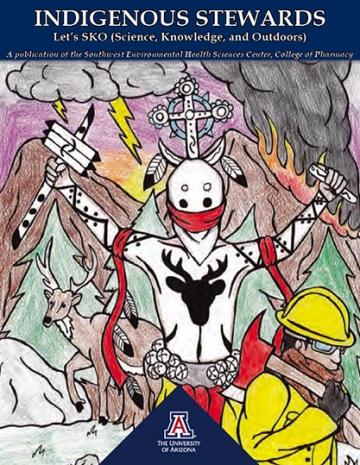
Volume four of the Indigenous Stewards magazine follows in the tradition of story-telling which our ancestors have used for generations to pass down knowledge.
Indigenous students and young professionals across The University of Arizona and various other entities shared their stories with the hopes of inspiring younger generations.
These stories include:
- Experiences in high school and undergraduate opportunities at The University of Arizona
- Events hosted by student-run organizations across The University of Arizona
- Personal endeavors in land stewardship
- Voices from young leaders across Indian Country who are invested in sharing knowledge and building capacity with younger generations.
This intergenerational sharing of knowledge will hopefully lead Indigenous youth from across Indian Country to pursue higher education and/or traditional education systems to continue Indigenous stewardship.
Click here to access the full publication of Volume 4
SUMMARY
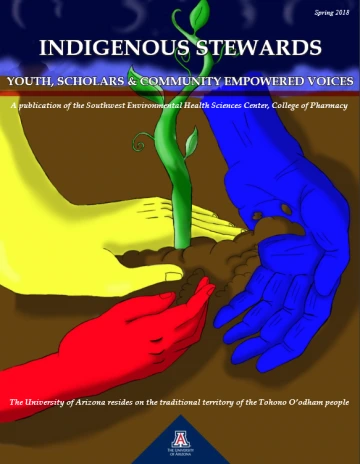
Spring 2018 has brought the third volume of Indigenous Stewards to life, which would have not been possible if it were not for more than 300 individuals. All journeys and knowledge shared are just as colorful as the cover artwork that recognizes the need for all hands to assist in healing our Mother Earth.
Volume three has truly come a long way to share the empowered voices of the youth, scholars, and communities. These voices are working to address environmental health and how the environment affects human health and how we impact our environment.
The magazine highlights various youths who are taking initiatives as environmental advocates. Our youth are not waiting, but acting now in innovative ways to make changes that will improve their home communities.
A key feature is Dr.PH. Stephanie Carroll Rainie who works to create “Data Warriors”. These warriors are individuals working towards a vision of healthy, sustainable communities by claiming the development of one’s own tribal data – for the tribe by the tribe. Data that advance tribal aspirations for collective and individual well-being within the Indigenous nations.
Among the stories are various programs that display youth who have flourished and made connections with Elders such as the Protecting Our Lands Camp, The Native Men’s Prayer Circle, and the second Tribal Environmental Health Forum.
Click here to access the full publication of Volume 3
SUMMARY
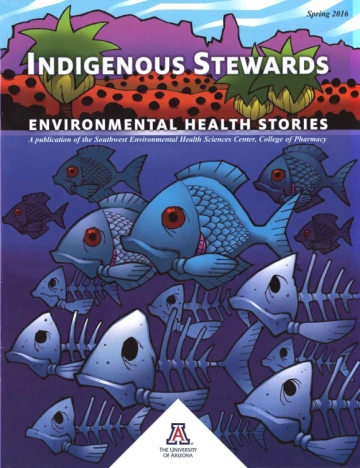
The spring 2016 issue of Indigenous Stewards continued through the support of the Agnes Nelms Haury Program and the National Institute of Environmental Health Sciences. In this second volume, the publication focused on environmental awareness by highlighting those who are researching the mechanisms behind human disease risks such as environmental exposures.
Featured are individuals’ journeys of experiencing environmental impacts in their home communities. Their stories’ entwine what motivated them to pursue and accomplish their doctoral degrees and to give back to their communities; such as Dr. Karletta Chief, Dr. Monica Yellowhair, and Ph.D. Candidate Carrie Nuva Joseph, who have been affected by the mining of coal and/or uranium. Their various research includes understanding how natural and human disturbances may affect soil hydrology, investigating climate change and its effects on indigenous communities, and the effects of uranium on DNA in relation to cancer in comparison to the role of the environment and diet tendencies.
Indigenous Stewards looks to continue to expand resources through partnerships outside of Arizona, for example with the Swinomish Indian Tribal Community. A wonderful model was developed to gain more insight as to the meanings and priorities of health from a Swinomish point of view known as “Indigenous Health Indicators”. Included in this issue are works of writings and photography of Indigenous youth, and the Center’s efforts to engage youth in environmental science by hosting Environmental Health Conferences. Highlighted is the first Tribal Environmental Health Forum, which took place in April 2015 to promote the sharing of stories about health and the environment.
SUMMARY
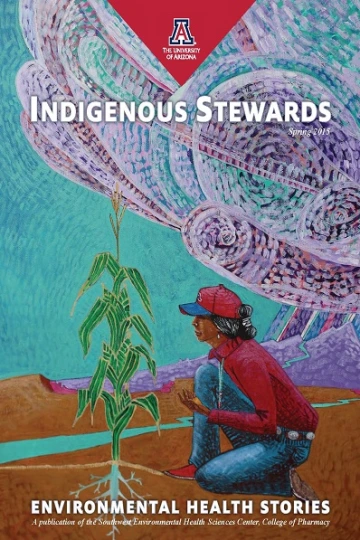
Indigenous Stewards is a product of the Native Environmental Health Stories Project. It was created in collaboration between the Southwest Environmental Health Sciences Center at the College of Pharmacy and the Center for Ecogenetics at the University of Washington. The publication focuses on issues and topics related to the health and the environment among Indigenous communities.
Amanda Bahe, Editor in Chief, and Gilbert L. Rivera Jr., Publisher, hope the magazine will begin conversations regarding environmental factors that affect everyday lives. Both Bahe and Rivera are outreach specialists in SWEHSC and have actively participated in the creation of the magazine.
The magazine includes features on community organizations and news stories on environmental topics, such as arsenic contamination in water. It also includes a section highlighting Indigenous leaders involved in environmental sciences. These leaders share their wisdom with Indigenous youth in the publication.
Approximately 75 people attended a November open house event to announce the magazine. "We wanted people to understand the purpose of releasing an environmental magazine and what our hopes are for it", Bahe says.
At the event, several authors featured in the magazine spoke about their work. Monica Yellowhair (Navajo), College of Pharmacy and post-doctoral research assistant at the University of Arizona Cancer Center, talked about her research related to uranium on the Navajo Nation. Amy Juan (Tohono O'odham), a community organizer and co-founder of an environmental network, spoke about how she bridges her cultural upbringing with environmental activism. Mike Lindsey, a Cherokee storyteller, discussed the power of storytelling to address issues and find solutions.
Click here to access the full publication of Volume 1
Contact
For information on the upcoming volume and past volumes please contact Sofia Forier-Montes
Hard copies of the magazine are circulated on a first-come-first-serve basis.
To request hard copies please contact Sofia Forier-Montes by email.
